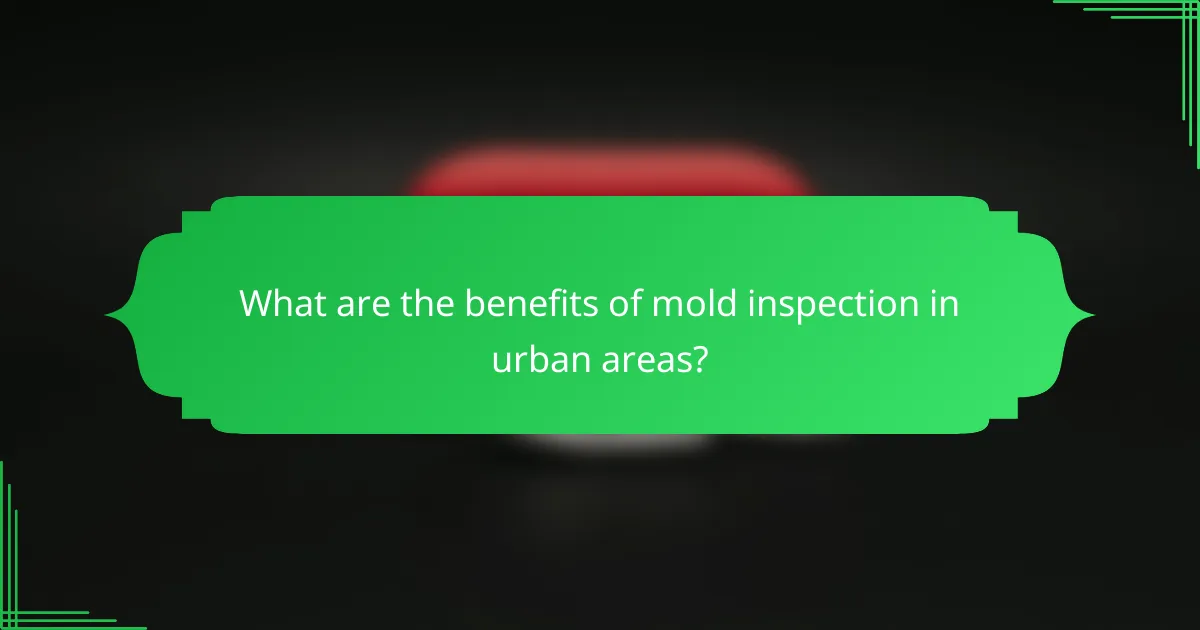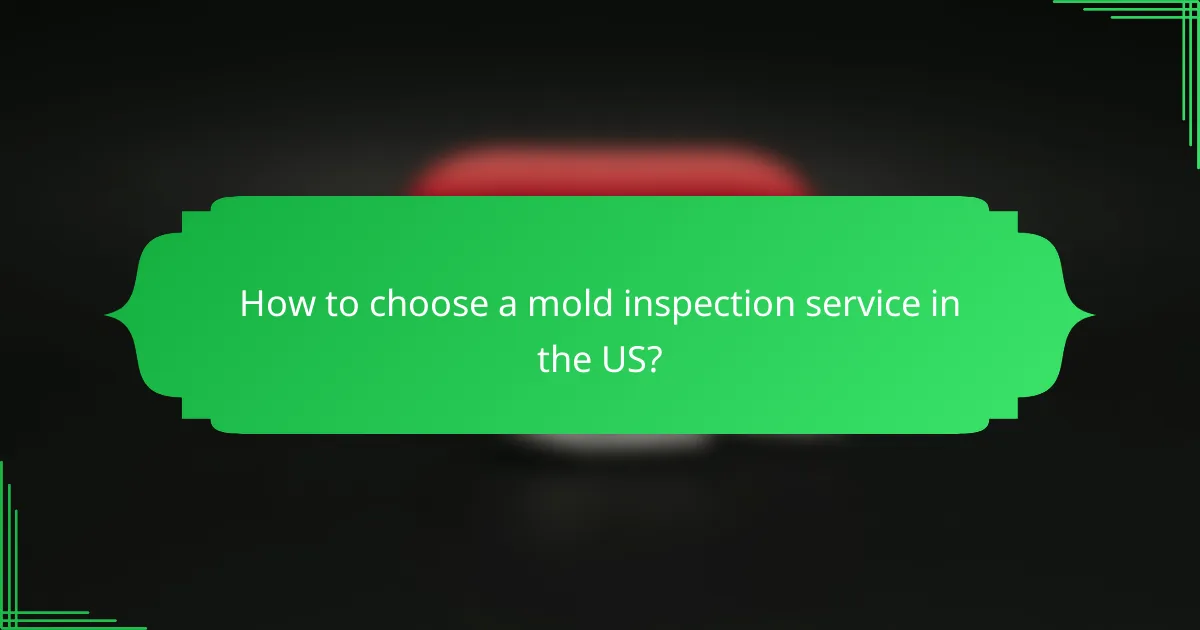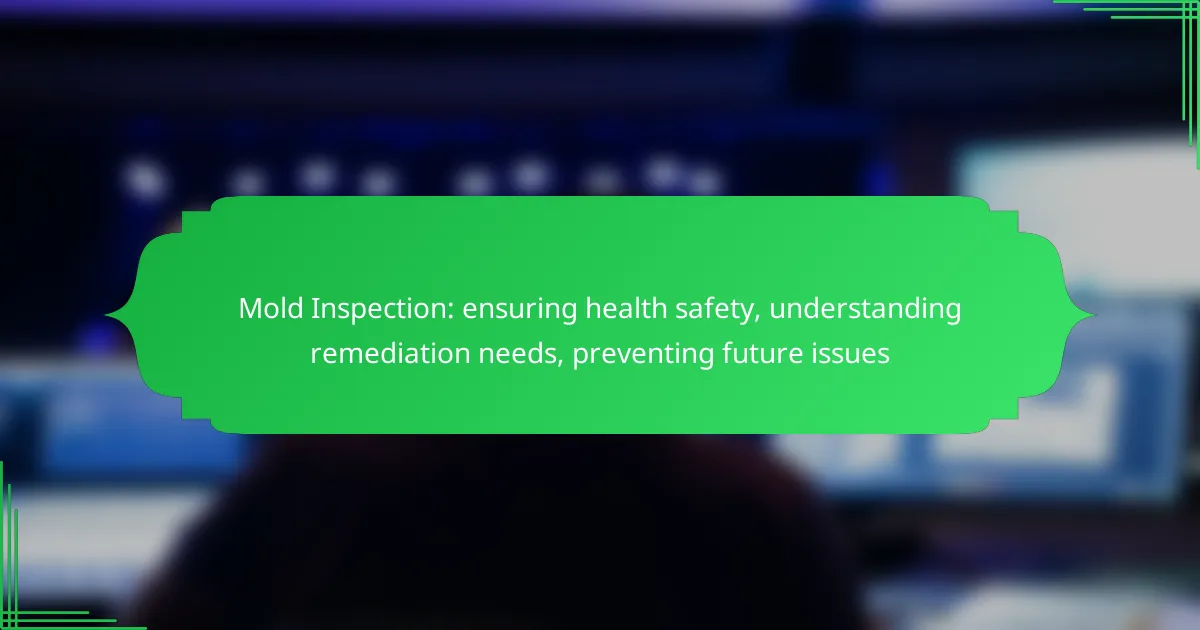Mold inspection is essential for maintaining health safety and preventing future issues related to mold growth. By identifying mold early through thorough assessments, property owners can address remediation needs promptly, protecting both their health and property value. Engaging certified professionals ensures a comprehensive evaluation and effective solutions tailored to each situation.

What are the benefits of mold inspection in urban areas?
Mold inspection in urban areas provides critical insights into potential health risks, property value protection, and the prevention of allergy and asthma issues. Regular inspections help identify mold growth early, allowing for timely remediation and safeguarding the well-being of residents.
Health risk assessment
A mold inspection offers a thorough health risk assessment by identifying mold types and concentrations present in the environment. This is crucial in urban areas where high humidity and population density can exacerbate mold growth. Understanding the specific mold species can help determine potential health impacts, particularly for vulnerable populations.
Inspectors often use air quality testing and surface sampling to evaluate mold levels. If mold is detected, it is essential to assess the extent of exposure and implement appropriate remediation strategies to mitigate health risks.
Property value protection
Conducting a mold inspection protects property value by ensuring that any mold issues are addressed before they escalate. Mold can significantly decrease a property’s marketability and value, especially in urban settings where real estate competition is high. Buyers are often wary of properties with a history of mold problems.
By identifying and remediating mold issues early, homeowners can maintain their property’s value and avoid costly repairs down the line. Regular inspections can also provide documentation that reassures potential buyers about the property’s condition.
Allergy and asthma prevention
Mold inspection plays a vital role in preventing allergies and asthma attacks, particularly in urban environments where air quality can be compromised. Mold spores can trigger allergic reactions and respiratory issues, making it essential to identify and eliminate mold sources.
For individuals with pre-existing conditions, such as asthma, even low levels of mold can pose serious health risks. Regular inspections and prompt remediation can significantly reduce the likelihood of mold-related health problems, promoting a healthier living environment.

How to choose a mold inspection service in the US?
Choosing a mold inspection service in the US involves evaluating their qualifications, reputation, and the range of services they offer. Focus on certified professionals with positive customer feedback and a comprehensive approach to mold assessment and remediation.
Certification and experience
Look for mold inspection services that are certified by recognized organizations such as the Institute of Inspection, Cleaning and Restoration Certification (IICRC) or the National Association of Mold Professionals (NAMP). These certifications indicate that the inspectors have undergone rigorous training and adhere to industry standards.
Experience is equally crucial; consider companies that have been in business for several years. An experienced inspector will be familiar with common mold issues in your area and can provide more accurate assessments and recommendations.
Customer reviews and ratings
Customer reviews and ratings can provide valuable insights into the reliability and quality of a mold inspection service. Check platforms like Google, Yelp, or Angie’s List for feedback from previous clients.
Pay attention to recurring themes in reviews, such as punctuality, thoroughness, and customer service. A service with consistently high ratings and positive testimonials is likely to meet your expectations.
Service offerings comparison
When comparing mold inspection services, assess the range of services they provide. Some companies may only offer inspections, while others include air quality testing, moisture assessments, and remediation plans.
Request detailed quotes from multiple services to understand what is included. Look for transparency in pricing and clarity on what each service entails, as this can help you make an informed decision based on your specific needs.

What are the steps in a mold inspection process?
The mold inspection process typically involves several key steps to identify and assess mold presence and potential health risks. These steps include visual assessments, air quality testing, and surface sampling to ensure a comprehensive evaluation of the environment.
Visual assessment
A visual assessment is the initial step in the mold inspection process, where an inspector examines the property for visible signs of mold growth. This includes checking areas prone to moisture, such as basements, bathrooms, and around windows.
During this assessment, inspectors look for discoloration, water stains, and any musty odors that may indicate mold presence. It’s essential to document findings and take note of any conditions that could lead to mold growth, such as leaks or poor ventilation.
Air quality testing
Air quality testing measures the concentration of mold spores in the air, providing insight into potential health risks. This testing is often conducted using specialized equipment that captures air samples for laboratory analysis.
Inspectors typically take samples from various locations within the property, including areas with visible mold and those without. Results can help determine if mold remediation is necessary and guide the scope of any required actions.
Surface sampling
Surface sampling involves collecting samples from surfaces suspected of harboring mold, such as walls, ceilings, or furniture. This method can confirm the presence of mold and identify its type, which is crucial for determining the appropriate remediation strategy.
Common techniques for surface sampling include tape lifts, swabs, and bulk samples. Each method has its advantages, and the choice may depend on the specific situation and the inspector’s expertise.

What are common signs of mold presence in homes?
Common signs of mold presence in homes include visible mold growth, musty odors, and indications of water damage. Recognizing these signs early can help prevent health issues and costly remediation efforts.
Visible mold growth
Visible mold growth can appear in various colors, including black, green, or white, and often looks fuzzy or slimy. It typically thrives in damp areas such as bathrooms, kitchens, and basements. If you spot mold, it’s essential to address it promptly to prevent further spread.
Check for mold in hidden areas, such as behind wallpaper or under carpets, where moisture may accumulate. If you find extensive growth, consider hiring a professional for safe removal.
Musty odors
Musty odors are a strong indicator of mold presence, often described as earthy or damp. If you notice this smell, it may suggest hidden mold growth in your home. Pay attention to areas with poor ventilation, as they are more prone to mold issues.
To address musty odors, increase airflow by opening windows and using fans. If the smell persists, investigate potential sources of moisture and consider a thorough inspection.
Water damage indications
Water damage indications include stains, discoloration, or warping on walls and ceilings. These signs often suggest past or present moisture issues, creating an environment conducive to mold growth. Regularly inspect areas prone to leaks, such as roofs, plumbing, and appliances.
Address any water damage immediately by repairing leaks and drying affected areas. Implementing proper ventilation and humidity control can help prevent future mold problems.

How does mold remediation work?
Mold remediation involves a systematic process to remove mold and prevent its return, ensuring a safe environment. This process typically includes containment, removal, and testing to confirm the effectiveness of the remediation efforts.
Containment procedures
Containment procedures are essential to prevent mold spores from spreading during the remediation process. This often involves sealing off the affected area with plastic sheeting and using negative air pressure to keep spores contained.
Common containment methods include using airlocks and dehumidifiers to control humidity levels, which can help minimize the risk of mold growth in unaffected areas. It’s crucial to ensure that all entry points are properly sealed to maintain containment integrity.
Removal techniques
Removal techniques vary based on the extent of mold growth and the materials affected. Non-porous materials can often be cleaned with specialized solutions, while porous materials like drywall may need to be removed and replaced.
Common methods include scrubbing surfaces with antimicrobial solutions, using HEPA vacuums to capture spores, and employing soda blasting or dry ice blasting for more extensive infestations. Always follow safety guidelines and wear appropriate protective gear during removal.
Post-remediation testing
Post-remediation testing is crucial to ensure that the mold has been effectively removed and that the environment is safe. This typically involves air quality testing and surface sampling to detect any remaining spores.
Testing should be conducted by a qualified professional who can interpret the results and determine if further remediation is necessary. It’s advisable to wait a few days after remediation before testing to allow any residual spores to settle. Regular follow-up inspections can help prevent future mold issues.
